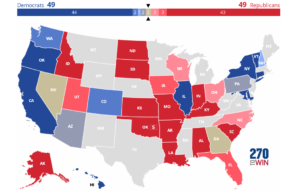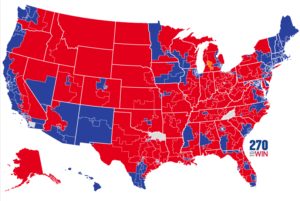As we prepare for the 2020 elections, Yesh Ginsburg and Steen Kirby will give a general overview of all 435 United States House of Representatives races. This is a basic overview to introduce you to the major candidates. All Partisan Lean numbers are taken from the Cook Partisan Voting Index. We will update this page as the races progress if anything noteworthy arises.
Alabama is a deep red state, with Republicans representing six of the seven Congressional Districts. None of the races in Alabama are expected to be particularly close, but that doesn’t mean they should be ignored. It’s always worth meeting the candidates and looking towards who will likely represent their districts in Congress.
Alabama’s 1st Congressional District
Incumbent: Bradley Byrne (Republican, third term)
Partisan Lean: R+15
2018 Results:
| Candidate | Votes | % |
| Bradley Byrne (R) | 153,228 | 63.16 |
| Robert Kennedy Jr. (D) | 89,226 | 36.78 |
| Write-ins | 163 | .07 |
2016 Results:
| Candidate | Votes | % |
| Bradley Byrne (R) | 208,083 | 93.36 |
| Write-ins | 7,810 | 3.62 |
Republican Candidate:
Jerry Carl (campaign website)
Byrne gave up his seat to try to run for Senate, where he finished third in the primary. This was a tightly contested Republican primary, with Carl and Bill Hightower finishing within 2% of each other. However, Carl easily won the hotly contested runoff, in which the large majority of spending was negative advertising against Carl. Carl won on an Alabama-specific campaign, while Hightower had more of a national brand, including endorsements from Ted Cruz and Rick Santorum. Carl was endorsed by Byrne, which carried the day.
As far as the general election goes, though, Carl is a pretty standard pro-Trump Southern Republican, which should carry the day in this strong Republican district.
Democratic Candidate:
James Averhart (campaign website)
Unlike in 2016, when no Democrat even ran for this seat, we had a three-person primary in 2020. Averhart came in second in the primary behind Kiani Gardner, but he cruised to a 13-point victory in the runoff. In a rarity, Averhart so thoroughly won the runoff campaign that Gardner’s vote percentage actually decreased from the primary to the runoff.
Yesh’s notes: Averhart has not been presenting detailed plans for Congress, but rather is choosing to stick with general goals. He is clearly trying to paint himself as a relatively moderate Democrat, though some of his campaign language (e.g. “healthcare should be a basic human right––not a privilege”) is clearly liberal language. Averhart is running this campaign to win, but it’s hard to see how much success he’ll have in a district this red.
Alabama’s 2nd Congressional District
Incumbent: Martha Roby (Republican, fifth term)
Partisan Lean: R+16
2018 Results:
| Candidate | Votes | % |
| Martha Roby (R) | 138,869 | 61.39 |
| Tabitha Isner (D) | 86,931 | 38.43 |
| Write-ins | 420 | .19 |
2016 Results:
| Candidate | Votes | % |
| Martha Roby (R) | 134,886 | 48.77 |
| Nathan Mathis (D) | 112,089 | 40.53 |
| Write-ins | 29,609 | 10.71 |
Republican Candidate:
Barry Moore (campaign website)
Moore won a fascinating runoff to earn the nomination. He was nearly doubled in the primary by Jeff Coleman, who received 38% of the vote in the seven-candidate field. However, he could not build on that in the runoff, and Moore took it with 60% of the vote. Moore painted himself as the establishment Alabama candidate, while Coleman was the “outsider” businessman. Coleman spent almost $2 million more than Moore in the race, but Moore won.
Yesh’s notes: The Republicans could not have been happy to see Roby not run again, as she was a popular Congresswoman, and one of only 13 Republican women in Congress. Moreover, she outperformed her 2016 showing (and her district’s lean) in 2018. However, this should be a relatively safe race for Republicans anyway, so there is likely not too much concern.
Democratic Candidate:
Phyllis Harvey-Hall (campaign website)
Harvey-Hall easily won her primary over 2016 candidate Nathan Mathis. She is running on a decidedly moderate Democratic platform, though with the relatively conservative notion of re-introducing civics into school curricula in there. She is also in favor of a pretty big federal minimum wage hike.
Alabama’s 3rd Congressional District
Incumbent: Mike Rogers (Republican, eighth term)
Partisan Lean: R+16
2018 Results:
| Candidate | Votes | % |
| Mike Rogers (R) | 147,770 | 63.72 |
| Mallory Hagan (D) | 83,996 | 36.22 |
| Write-ins | 149 | .06 |
2016 Results:
| Candidate | Votes | % |
| Mike Rogers (R) | 192,164 | 66.93 |
| Jesse Smith (D) | 94,549 | 32.93 |
| Write-ins | 391 | .14 |
Republican Candidate:
Mike Rogers (campaign website)
We finally have our first Alabama incumbent. Looking at the last two election results, Rogers should have nothing to fear. Rogers is very conservative, very pro-life, and well-liked in Alabama. The last time he earned under 60% in an election was in 2010.
Democratic Candidate:
Adia Winfrey (campaign website)
Winfrey came up short in the 2018 primary against Mallory Hagan, but ran unopposed this year. Her 2018 campaign was not without controversy, and it’s unclear how much campaigning she is doing in 2020. Her official website has no platform, her campaign Facebook mostly posts asking for donations, and her campaign Twitter has tweeted once since 2018 (it did retweet a call to wear masks, from a tweet that specifically tagged it).
Alabama’s 4th Congressional District
Incumbent: Robert Aderholt (Republican, 12th term)
Partisan Lean: R+30
2018 Results:
| Candidate | Votes | % |
| Robert Aderholt (R) | 184,255 | 79.77 |
| Lee Auman (D) | 46,492 | 20.13 |
| Write-ins | 222 | .11 |
2016 Results:
| Candidate | Votes | % |
| Robert Aderholt (R) | 208,083 | 93.36 |
| Write-ins | 3,519 | 1.47 |
Republican Candidate:
Robert Aderholt
Aderholt has no campaign website, but he doesn’t need it. After 12 terms in Congress, his district knows him, and they clearly like him. Aderholt has run unopposed several times, and has received at least 70% of the vote in every election since 2000. In one of the country’s reddest districts, he’s consistently outperforming its partisan lean.
Democratic Candidate:
Rick Neighbors (campaign website)
Neighbors didn’t have to face a primary. He has a background that should resonate well with the district, and he’s clearly not running on a very liberal agenda. He’s the type of candidate who could get a second look if he wasn’t facing a popular incumbent. (Winning in an R+30 district would be nigh impossible, but he could at least force his opponent to campaign.) Unfortunately for him, that’s exactly what he’s up against.
Alabama’s 5th Congressional District
Incumbent: Mo Brooks (Republican, fifth term)
Partisan Lean: R+18
2018 Results:
| Candidate | Votes | % |
| Mo Brooks (R) | 159,063 | 61.02 |
| Will Boys (D) | 101,388 | 38.43 |
| Write-ins | 222 | .09 |
2016 Results:
| Candidate | Votes | % |
| Mo Brooks (R) | 205,647 | 66.70 |
| Peter Joffrion (D) | 102,234 | 33.16 |
| Write-ins | 445 | .14 |
Republican Candidate:
Mo Brooks (campaign website)
Brooks is a member of the House Freedom Caucus and is relatively popular. His margin of victory in elections shrunk a net 27 points from 2014 through 2018, though that won’t matter this year as he’s running unopposed.
Democratic Candidate:
There is no Democrat running in this race.
Alabama’s 6th Congressional District
Incumbent: Gary Palmer (Republican, third term)
Partisan Lean: R+26
2018 Results:
| Candidate | Votes | % |
| Gary Palmer (R) | 192,542 | 69.2 |
| Danner Kline (D) | 85,644 | 30.8 |
| Write-ins | 142 |
2016 Results:
| Candidate | Votes | % |
| Gary Palmer (R) | 245,313 | 74.96 |
| David Putnam (D) | 83,709 | 24.95 |
| Write-ins | 284 | .09 |
Republican Candidate:
Gary Palmer (campaign website)
Palmer is a right-wing Republican. He is popular and is in a solid red district.
Yesh’s notes: Palmer faces no Democratic opposition, though Kaynen Pellegrino has filed for this race as an independent. Pellegrino is running on the notion that the two-party system is currently failing us. While there are some districts where this campaign could find traction, it’s unlikely this is one of them. Also, Pellegrino is not campaigning particularly aggressively, so it’s unlikely he attracts any more attention than a standard third-party run.
Democratic Candidate:
There is no Democrat running in this race.
Alabama’s 7th Congressional District
Incumbent: Terri Sewell (Democrat, fifth term)
Partisan Lean: D+20
2018 Results:
| Candidate | Votes | % |
| Terri Sewell (D) | 185,010 | 97.80 |
| Write-ins | 4,153 | 2.20 |
2016 Results:
| Candidate | Votes | % |
| Terri Sewell (D) | 229,330 | 98.41 |
| Write-ins | 3,698 | 1.59 |
Republican Candidate:
There is no Republican running in this race.
Democratic Candidate:
Terri Sewell (campaign website)
Sewell is popular in her district, and used to being Alabama’s sole Democrat in Congress. She has been joined by Doug Jones since he beat Roy Moore, though expect that to change in 2021. Sewell will still be in Congress, but it’s highly unlikely that Jones will. Republicans know they will not win this district, so Sewell is running unopposed for the fourth consecutive election.
Outlook
We are entering the 2020 elections with six Republicans and one Democrat in the House from Alabama, and it would be quite a surprise to see us leave the elections with anything different.
Interested in the rest of our primers for other House races? We have them all listed on our primer home page.







